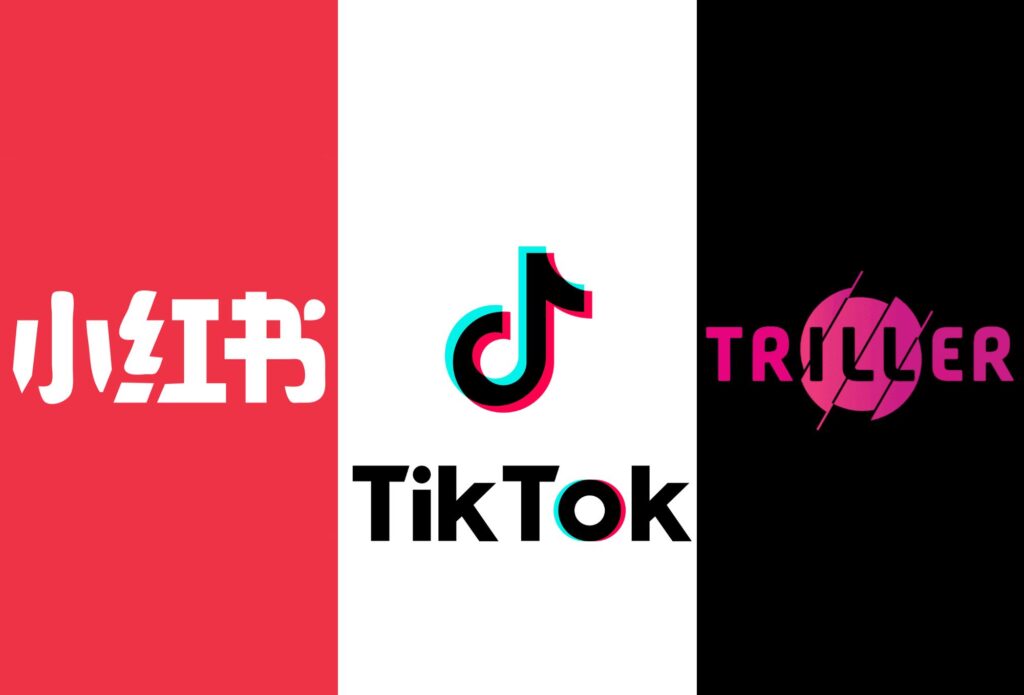In the world of social media, no app has replicated the cultural impact of TikTok. Its addictive short-form content, infinite scrolling and endless creativity made it a global phenomenon.
While banned, users immediately scrambled for alternatives. Those tense 14 hours without TikTok, though brief, exposed a deep truth: a collective need for the instant gratification and connection social media provides. Apps like RedNote and Triller saw a surge in popularity, capitalizing on the opportunity. For many, the switch wasn’t about loyalty or preference but urgency.

Rednote (left) and Triller (right). Logos courtesy of RedNote, TikTok and Triller
Students like nuclear medicine technology sophomore, Morgan Bowman downloaded the app as a replacement for TikTok. The language barrier was a notable difference to her, and it took her some time to figure out how to receive videos in English.
“The time that TikTok was banned wasn’t horrible considering I was asleep for half of that time, but when I woke up I tried to open the app a few times out of muscle memory,” Bowman said. “People are definitely too reliant on apps like TikTok and I am one of them. It’s my main source of entertainment and I know I’m not the only one.”
People needed something to scroll through, a digital outlet to maintain their routines. Although she has moved back to TikTok, Bowman said she will keep RedNote incase TikTok goes down anytime soon.
“I am not using RedNote anymore since I never deleted TikTok from my phone,” Bowman said. “TikTok is more tailored to my sense of humor already and I get more content relevant to me and where we live”
The need to fill downtime, distract from stress or feel connected was universal. TikTok’s brief absence revealed how deeply social media had become a habit, a reflex and a source of comfort for many.
As users shifted to other platforms, frustration grew. Posts didn’t feel as well curated, communities weren’t as established and trends lacked the same viral momentum. Still, millions flocked to apps like RedNote to recreate the experience they were losing out on.
This shift created surprising connections between users in the U.S. and China, with people from both countries sharing content and engaging in meaningful conversations.
For example, in an episode of the Weekend Editon podcast by National Public Radio, Tylir Russ, a farmer from Virginia, talks about how she gained thousands of followers from China after posting videos about her life on the farm, sparking mutual interest and connections. RedNote allowed for direct communication between users in both countries, bypassing the usual digital barriers caused by censorship in China.
For some, the change was less about the content and more about the structure of social media as a coping mechanism. Scrolling through curated streams of videos, sounds and trends had become ingrained in daily life. Platforms like this have seemingly re-wired how users seek interaction, making digital connection almost as essential as in-person contact.
This temporary migration underscored how dependent modern society is on platforms that blend entertainment and community. People didn’t just lose an app, they lost a digital space where they felt seen, heard and inspired. The void highlighted how intertwined social media has become with identity, creativity and belonging.
At the same time, the shift sparked an interesting behavioral change. With fewer established communities and looser algorithms, platforms like Rednote encouraged more experimentation.
In some ways, this forced reinvention helped people reconnect with more playful, less commercially driven aspects of social media. On Rednote, for example, users could explore unfiltered creativity, experimenting with quirky, low-budget video edits and off-the-wall soundtracks that wouldn’t necessarily fit the polished, brand-focused environment of TikTok.
Creators who had felt constrained by TikTok’s rigid cycles found themselves exploring new ideas and styles. Users discovered niches they hadn’t encountered before, from obscure genres of music to unexpected creative formats.
This transition also posed challenges. Content creators who had spent years building audiences on TikTok faced an abrupt disruption. Many had to start over on unfamiliar platforms, struggling to re-establish followings. Meanwhile, users accustomed to TikTok’s fast-paced trends found the new platforms slowed to pick up momentum. It wasn’t just the loss of an app; it was the loss of a cultural rhythm set by TikTok.
The TikTok ban also fueled global conversations about social media dependency. While some welcomed the chance to reconsider their screen time, most users flocked to alternatives, underscoring the need for these digital spaces.
It wasn’t just about entertainment; it was about connection. Social media has become a cornerstone of modern culture. A space for humor, inspiration and solace in times of isolation or uncertainty.
Ultimately, the TikTok migration wasn’t just about finding a new app. It highlighted the growing role of social media in modern life. As platforms shape how people connect, create and even pass the time, the absence of one reveals just how dependent users have become on these digital spaces.
